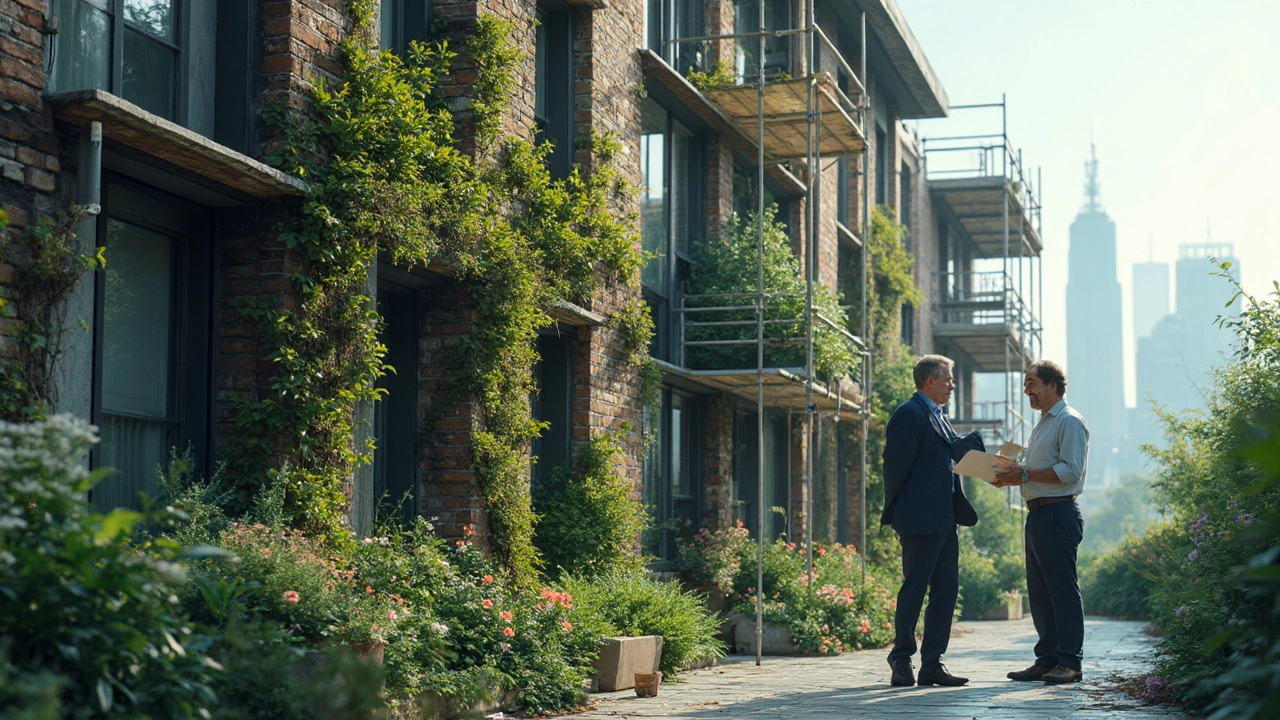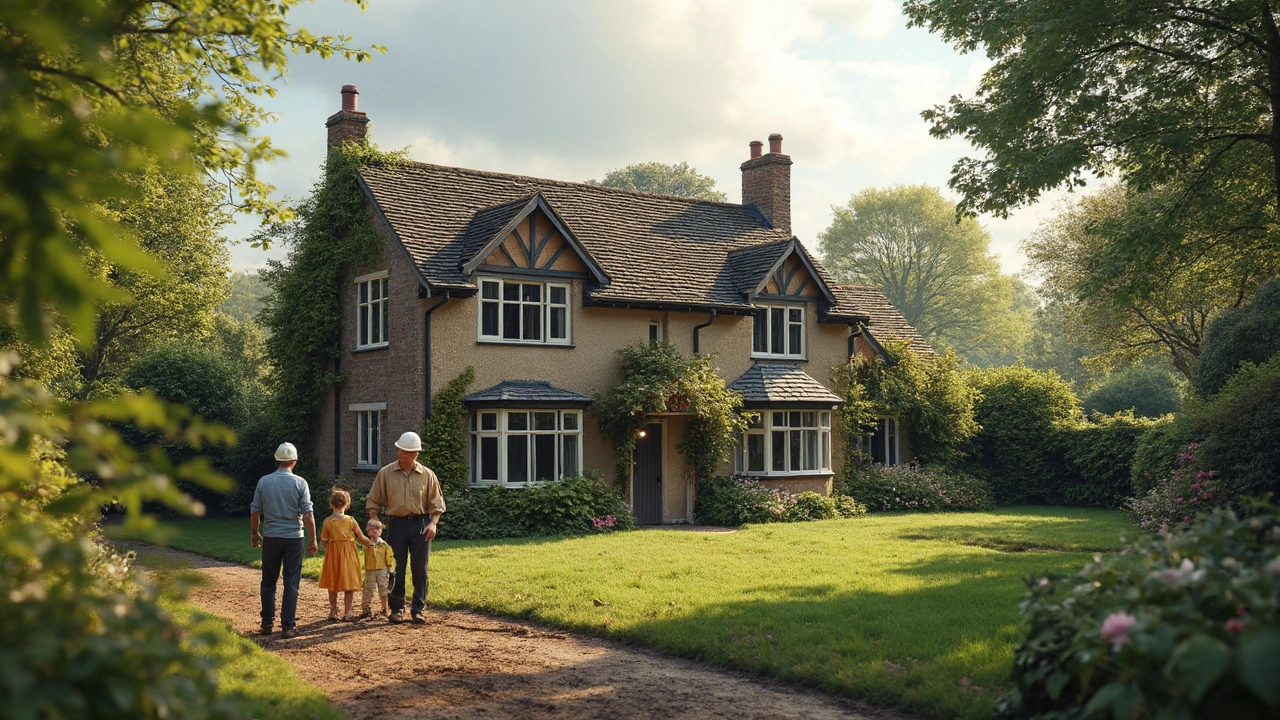Everywhere you look, builders and designers rave about green buildings. But before you pour your savings into an eco-friendly cottage, you better know what you’re really signing up for. The sticker price? It can be a punch to the gut. Even if you're cutting back on square footage, the costs for certified materials, energy-efficient systems, or even just the extra paperwork can jump way above what you’d pay for a standard build.
Here’s something that might surprise you: just because you throw in triple-glazed windows or a fancy rainwater system, doesn’t mean your house will be snug and problem-free. These upgrades sometimes need special maintenance and can break down in ways your old-school family home never would. Ever paid thousands just for a tiny part to fix a “green” feature? It happens more than people admit.
- Green Isn't Always Cheap
- Chasing Certifications: More Hassle Than It's Worth?
- Hidden Maintenance Surprises
- Comfort and Practicality: What Gets Lost?
- Smart Tips Before You Build Green
Green Isn't Always Cheap
It might seem like building an eco-friendly cottage should save you money. After all, you’re trying to use less energy and fewer resources, right? But here’s the kicker: a lot of those green choices come with a much bigger price tag than you’d expect. According to recent U.S. building industry stats, putting up a green building tends to cost about 10-20% more than a regular house of the same size, and sometimes that jumps even higher for small projects like cottages.
So, where does all the money actually go? The biggest hits usually come from:
- Certified building materials (like FSC wood or low-VOC paints)
- Special energy systems (solar panels, rainwater collection, super-insulated walls)
- Extra layers of design and approval for building standards and sustainability certifications
If you’re after that sweet LEED or Passive House plaque on your wall, brace yourself for fees, paperwork, and even more inspections. Sometimes, just chasing those certifications can suck thousands out of your pocket.
Here’s a table that shows a quick snapshot of common costs for green buildings versus traditional options:
| Feature | Green Building Cost | Conventional Cost |
|---|---|---|
| Insulation (high R-value) | $8,000 | $3,500 |
| Windows (triple glazed) | $12,000 | $6,000 |
| Solar panel system | $18,000 | N/A |
| Certification & Design Fees | $7,000 | $0 |
Here’s another twist: in some rural areas, it can be hard to even find local builders who know their way around green construction. If you have to bring in experts from out of town, travel and labor fees climb even higher.
The bottom line is, going green is awesome for the planet but can be rough on your wallet up front. Before you commit, it’s smart to run the actual numbers for your location and build size. There are ways to save (like using recycled materials or doing some work yourself), but the dream of a cheap green cottage is usually just that—a dream.
Chasing Certifications: More Hassle Than It's Worth?
Getting a cottage certified as a green building might look great on paper, but the process can be brutal. You’ve probably seen folks brag about hitting LEED, BREEAM, or Passivhaus standards. What most don’t talk about is the time, paperwork, and money these certifications eat up—especially if you just want a cozy, eco-friendly cottage.
For starters, LEED fees alone can run from a few hundred up to several thousand dollars, just for paperwork and the certificate. Then there’s hiring consultants to make sure every checkbox is ticked. That’s on top of paying extra for some materials because they’re on the “approved” list, even though similar products might be just as good but don’t come with the right sticker.
And the surprises don’t end there. Because strict certifications demand perfect documentation, builders can get stuck in endless rounds of corrections. Something as simple as swapping a faucet can trigger extra reviews or delays.
- Time-consuming: Expect longer building timelines. Every change has to be justified and documented.
- Costly audits: Getting a third-party to check your materials and energy systems isn't free. Some folks pay for multiple rounds before passing.
- Ongoing rules: Want to add a shed or change your porch? You might need approval again later, depending on your certification.
Here's a look at just a few typical costs you might face when chasing top certifications for eco-friendly cottages:
| Certification Type | Application Fees | Consultant Costs |
|---|---|---|
| LEED v4 (Homes) | $225 – $900 | $1,000 – $5,000+ |
| Passivhaus | $2,000 – $4,000 | $3,000 – $10,000+ |
| BREEAM | $1,500 – $4,000 | $2,500 – $7,500+ |
So before you get caught in the certification trap, ask yourself why you’re doing it. Is it about bragging rights, or do you really need the plaque? Building an environmentally friendly cottage doesn’t have to mean getting tangled up in red tape and spending thousands. Sometimes, keeping it simple actually fits your green goals even better.

Hidden Maintenance Surprises
Going for a green building can be a learning curve, especially when it comes to upkeep. These cottages are packed with high-tech stuff like solar panels, special ventilation systems, rainwater harvesting tanks, and green roofs. Sure, these sound great, but once you move in, there’s more to think about than just lower energy bills.
Take solar panels, for example. They don’t just sit there and work forever. Dust, snow, or leaves can cut down their power, and parts may need replacing every few years. A solar inverter, which is the thing that makes your solar electricity usable at home, usually needs a swap every 7-10 years. That’s a cost most people forget the first time around.
And if you’ve picked those triple-glazed windows because you heard they’re top-notch for insulation, get ready: seals can fail, leading to foggy panes and worse insulation, and finding someone who knows how to fix them can be a hassle (and pricey). Same goes for water-saving toilets and faucets. They sometimes clog or need rare parts that take weeks to arrive. Not exactly what you want for your main bathroom.
A common headache? Some green features need specialists. For things like heat recovery ventilation systems or green roofs, your regular plumber or roofer may just shake their head. You can end up waiting for the right technician, or paying for pricey travel from companies that specialize in eco tech.
Check out this quick comparison of typical maintenance issues:
| Green Feature | What Can Go Wrong | Realistic Cost |
|---|---|---|
| Solar Panels | Inverter replacement | $800-$2,500 every 7-10 years |
| Triple-Glazed Windows | Seal failure | $300+ per window |
| Green Roof | Plant upkeep, leaks | $700+/year (professional maintenance) |
| Water-Saving Toilets | Valve clogs | $150-300 per repair |
A smart move? Before picking a super eco-friendly feature, ask about the real cost—both money and time—to keep it running. If you’re not a fan of DIY or hunting down rare parts, you might want simpler options for your eco-friendly cottages.
Comfort and Practicality: What Gets Lost?
Most folks dream of an eco-friendly cottage as a cozy, healthy retreat, but a lot of green building decisions can actually mess with your daily comfort. Ever walk into a 'green' home and feel like the air just doesn't move right? Super-insulated walls and windows might keep in heat, but sometimes they keep in too much. If your ventilation system isn’t tuned perfectly—and those setups are rarely simple—you might end up with stale air and extra humidity. Nobody brags about moldy walls.
Downsizing appliances and using low-flow water fixtures also makes sense for saving resources. But in real life, some people get frustrated with trickling showers or slow-to-wash dishwashers. There’s a line between being responsible and feeling annoyed every time you turn on a tap. Real talk: research out of the UK in 2022 found that 1 in 4 residents of newly-built 'eco homes' were unhappy with comfort, mainly because heating and hot water weren’t up to snuff. Tepid baths don’t make for happy campers.
Don’t forget noise. Some green buildings skip carpets and soft furnishings for materials like concrete or bamboo—yes, it’s eco, but echo in a cottage can turn a movie night into a headache.
| Green Feature | Common Issue |
|---|---|
| Super-insulated walls | Poor air circulation, stuffiness |
| Low-flow fixtures | Frustrating water pressure |
| Natural materials | Noise, less thermal mass |
If you’re planning your own eco-friendly cottage, try living with similar features for a week before committing. Do you like cool air at night? Make sure windows still open. Love good showers? Test the exact low-flow system you plan to buy.

Smart Tips Before You Build Green
Thinking about building an eco-friendly cottage? Hold up—planning smart can save you from big regrets later. Lots of folks get caught up in the dream and end up shocked by cost overruns or features they never actually use. Here’s how to make sure your green building project goes right.
- Set a Realistic Budget: Green features like high-efficiency insulation or solar panels aren’t cheap. According to EnergySage, solar panel installation for a typical home can run between $15,000 and $25,000 after incentives. Get detailed quotes up front and ask for a breakdown, so nothing sneaks up on you.
- Balance Sustainability and Practicality: Not every green upgrade pays off in every climate. In northern states, super thick insulation makes sense; in milder ones, you might be better off spending money on a heat pump or a smart thermostat. Look up what works for your climate zone before you commit.
- Double-Check Certifications: Chasing after every certificate (like LEED or ENERGY STAR) can turn into a paperwork vortex and ratchet up costs fast. Sometimes local rebates and simple energy audits deliver just as much benefit without turning your project into a bureaucratic mess.
- Think Long-Term Maintenance: Fancy filters, rainwater systems, and energy monitoring gadgets are great—until you need to fix or replace them. Talk to other homeowners with green cottages to find out which systems break down most, and what parts cost when things go wrong.
- Get an Experienced Builder: Ask your builder about other eco-friendly cottages they've worked on. Green construction has its quirks, and you want someone who's seen them all. Check reviews with specific mentions of green homes, not just generic testimonials.
Here’s a quick look at how a few popular green features stack up for cost and maintenance:
| Feature | Average Upfront Cost | Average Annual Maintenance |
|---|---|---|
| Solar Panels | $15,000 - $25,000 | $150 - $300 |
| Greywater Systems | $3,000 - $7,000 | $100 - $200 |
| High-Efficiency Windows | $600 - $1,000 each | $20 - $40 (occasional seal checks) |
Make a checklist of needs, wants, and must-haves. Sometimes, a simple design with a smaller square footage cuts your footprint and costs more than any state-of-the-art tech. And one last thing—don’t forget the boring stuff, like good roof overhangs or bug screens. Those are the details that make a green building last, without big repair bills.
